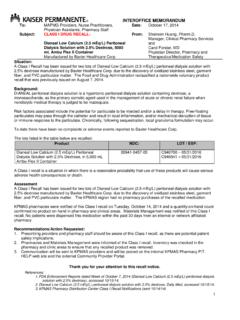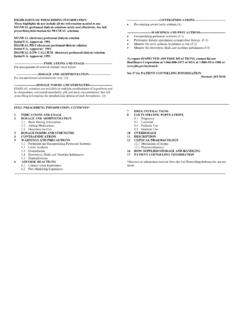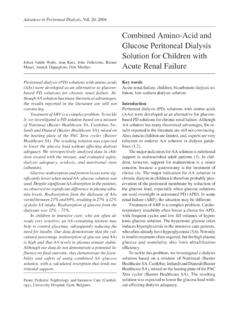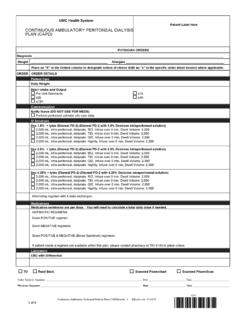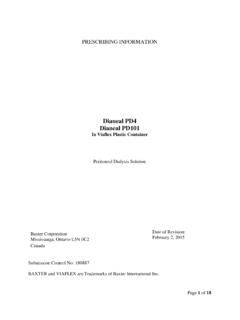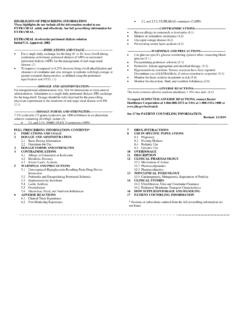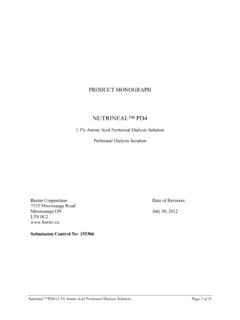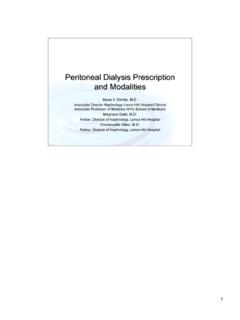Transcription of NEW ZEALAND DATA SHEET - Medsafe
1 NEW ZEALAND data SHEET dianeal data SHEET 20 June 2017 Page 1 of 10 Baxter Healthcare Ltd 1 dianeal (solution, dialysis ) dianeal 1mmol/L Calcium peritoneal dialysis Solution, dianeal 1mmol/L Calcium peritoneal dialysis Solution, dianeal 1mmol/L Calcium peritoneal dialysis Solution, dianeal PD 4 peritoneal dialysis Solution, Glucose 2 QUALITATIVE AND QUANTITATIVE COMPOSITION dianeal PD 4 and 1mmol/L Calcium peritoneal dialysis solutions are sterile, nonpyrogenic and contain no bacteriostatic or antimicrobial agents or added buffers. Each 1000mL of dianeal peritoneal dialysis Solution contains: Component ContentGlucose, BP % % or Chloride, BP Lactate Chloride Hexahydrate, BP Chloride Dihydrate, BP PD 2 257mg, PD 4 183mg, or 1mmol/L Calcium 147mg Water For Injections, BP QS dianeal 1mmol/L Calcium peritoneal dialysis Solution with Glucose with Glucose with Glucose Glucose.
2 H2O 76mmol/L126mmol/L 214mmol/LSodium 132mmol/L132mmol/L 132mmol/LCalcium 96mmol/L96mmol/L 96mmol/LLactate 40mmol/L40mmol/L 40mmol/LApproximate Osmolality 344mOs394mOs482mOs NEW ZEALAND data SHEET dianeal data SHEET 20 June 2017 Page 2 of 10 Baxter Healthcare Ltd dianeal PD 4 peritoneal dialysis Solution with Glucose Glucose .H2O 28mmol/L Sodium 132mmol/L Calcium Magnesium Chloride 96mmol/L Lactate 40mmol/L Approximate Osmolality 297mOs Potassium is omitted from dianeal solutions because dialysis may be performed to correct hyperkalaemia. Because average plasma magnesium levels in chronic Continuous Ambulatory peritoneal dialysis (CAPD) patients have been observed to be elevated (Nolph et al.)
3 1981), the magnesium concentration of this formulation has been reduced to Because average serum bicarbonate levels in chronic CAPD patients have been observed to be somewhat lower than normal values (Nolph et al. 1981), the bicarbonate precursor (lactate) concentration of this formulation has been raised to 40mmol/L. For the full list of excipients, see section 3 PHARMACEUTICAL FORM Solution, dialysis . 4 CLINICAL PARTICULARS Therapeutic indications dianeal PD 4 and 1mmol/L Calcium peritoneal dialysis Solution is indicated for use in chronic renal failure patients being maintained on Continuous Ambulatory peritoneal dialysis (CAPD). Dose and method of administration dianeal PD 4 and 1mmol/L Calcium solutions are intended for intraperitoneal administration only.
4 The mode of therapy (Continuous Ambulatory peritoneal dialysis ), frequency of treatment, formulation, exchange volume, duration of dwell and length of dialysis should be selected by the physician responsible for and supervising the treatment of the individual patient. To avoid the risk of severe dehydration and hypovolaemia and to minimise the loss of protein, it is advisable to select the peritoneal dialysis solution with the lowest level of osmolality consistent with the fluid removal requirements for that exchange. As the patient s body weight becomes closer to the ideal dry weight, lowering the glucose concentration of dianeal is recommended. dianeal glucose containing solution is a high osmotic pressure fluid and using it alone may cause dehydration (see section ).
5 NEW ZEALAND data SHEET dianeal data SHEET 20 June 2017 Page 3 of 10 Baxter Healthcare Ltd Heating the dialysis solution to 37 C (while in the overpouch) may decrease discomfort and heat loss and result in increased clearances of urea when compared to solution at room temperature (Gross and McDonald 1967). Only dry heat (eg. heating pad, warming plate) should be used; solutions should not be heated in water or in a microwave oven due to the potential for patient injury or discomfort. The addition of heparin to the dialysis solution may be indicated to aid in prevention of catheter blockage in patients with peritonitis, or when the solution drainage contains fibrinous or proteinaceous material (Ribot et al.)
6 1966). 1000 to 2000 International Units of heparin per litre of solution has been recommended (Furman et al. 1978). Continuous Ambulatory peritoneal dialysis (CAPD) For maintenance dialysis of chronic renal failure patients. In this technique, typically to litres of dialysis solution (depending upon patient size) are instilled into the peritoneal cavity and the peritoneal access device is then clamped. The solution remains in the cavity for dwell times of 4 6 hours during the day and approximately eight hours overnight. At the conclusion of each dwell period, the access device is opened, the solution drained and fresh solution instilled. The procedure is repeated 3 5 times per day, 6 7 days per week.
7 Typically the majority of exchanges will utilise and Glucose containing peritoneal dialysis solutions , with Glucose containing solutions being used when extra fluid removal is required. Patient weight is used as the indicator of the need for fluid removal (Popovich et al. 1978). Directions for Use dianeal solutions are intended for intraperitoneal administration only. Do not use for intravenous administration. Do not administer if the solution is discoloured, cloudy, contains particulate matter or shows evidence of leakage or if seals are not intact. Use aseptic technique throughout the peritoneal dialysis procedure. To add medication: 1. Prepare medication site. If the resealable rubber plug on the medication port is missing or partially removed, do not use product if medication is to be added.
8 2. Using syringe with 19 22 gauge needle, puncture resealable rubber plug at target area and inject. 3. Mix solution and medication thoroughly. For high density medication such as potassium chloride, squeeze medication port while port is upright and mix thoroughly. Preparation for Administration 1. Place container on table or suspend from support. 2. Remove protector from outlet port of container. 3. Attach solution transfer set; refer to complete directions accompanying set. The drained fluid should be inspected for the presence of fibrin or cloudiness, which may indicate the presence of peritonitis. Discard any unused remaining solution. For single use only. NEW ZEALAND data SHEET dianeal data SHEET 20 June 2017 Page 4 of 10 Baxter Healthcare Ltd Contraindications dianeal is contraindicated in patients with: hypersensitivity to the active substances or to any of the excipients listed in section pre existing severe lactic acidosis uncorrectable mechanical defects that prevent effective peritoneal dialysis or increase the risk of infection documented loss of peritoneal function or extensive adhesions that compromise peritoneal function.
9 Do not administer unless the solution is clear and the seal is intact. Special warnings and precautions for use Encapsulating peritoneal Sclerosis (EPS) is considered to be a known, rare complication of peritoneal dialysis therapy. EPS has been reported in patients using peritoneal dialysis solutions including dianeal . Infrequently, fatal outcomes of EPS have been reported with dianeal . Improper clamping or priming sequence may result in infusion of air into the peritoneal cavity, which may result in abdominal pain and/or peritonitis. If peritonitis occurs, the choice and dosage of antibiotics should be based upon the results of identification and sensitivity studies of the isolated organism(s) when possible.
10 Prior to identification of the involved organism(s), broad spectrum antibiotics may be indicated. solutions containing dextrose should be used with caution in patients with a known allergy to corn or corn products. Hypersensitivity reactions such as those due to a corn starch allergy, including anaphylactic/anaphylactoid reactions, may occur. Stop the infusion immediately and drain the solution from the peritoneal cavity if any signs or symptoms of a suspected hypersensitivity reaction develop. Appropriate therapeutic countermeasures must be instituted as clinically indicated. Patients with severe lactic acidosis should not be treated with lactate based peritoneal dialysis solutions (see section ). It is recommended that patients with conditions known to increase the risk of lactic acidosis [eg.]










